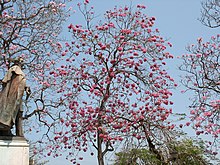Tabebuia rosea
| Tabebuia rosea | |
|---|---|

| |
| Scientific classification | |
| Kingdom: | Plantae |
| Clade: | Tracheophytes |
| Clade: | Angiosperms |
| Clade: | Eudicots |
| Clade: | Asterids |
| Order: | Lamiales |
| Family: | Bignoniaceae |
| Genus: | Tabebuia |
| Species: | T. rosea
|
| Binomial name | |
| Tabebuia rosea | |
| Synonyms[1] | |
|
List
| |
Tabebuia rosea, also called pink poui, and rosy trumpet tree[2] is a neotropical tree that grows up to 30 m (98 ft) and can reach a diameter at breast height of up to 100 cm (3 ft). The Spanish name roble de sabana, meaning "savannah oak", is widely used in Costa Rica, probably because it often remains in heavily deforested areas and because of the resemblance of its wood to that of oak trees.[3] It is the national tree of El Salvador, where it is called "Maquilíshuat".
Names
[edit]The tree is known as "tekoma" in Malaysia.[4]
The tree is known as "රොබරෝසියා (Robarōsiyā)" in Sri Lanka.[5]
The tree is known as "ชมพูพันธุ์ทิพย์" in Thailand.[6]
Distribution and habitat
[edit]This species is distributed from southern Mexico, to Venezuela and Ecuador. It has been found growing from sealevel to 1,200 m (3,937 ft), in temperatures ranging from 20 °C to 30 °C on average, with annual rainfall above 500 mm, and on soils with very variable pH.
This tree is often seen in Neotropical cities, where it is often planted in parks and gardens. In the rainy season it offers shade[original research?] and, in the dry season, abundant flowers are present on the defoliated trees.
Description
[edit]The tree is short length, with irregular, stratified ramification and only few thick branches. The bark can be gray to brown, in varying darkness and may be vertically fissured. Leaves are compound, digitate and deciduous. Each leaf has five leaflets of variable size, the middle one being the largest. Flowering occurs mainly in January and February, and is generally associated with dry periods; although flowering has also been observed in August, September, April and May. Flowers are large, in various tones of pink to purple, and appear while the tree has few or no leaves. Pollination occurs probably by insects, although the flowers are visited by many birds such as tanagers, hummingbirds and orioles. The long and slender fruit capsules can measure up to 35 cm (14 in) and appear from February through April. After the drying fruit dehisces, the anemochorous, hyaline-membrane-winged seeds are released. There are an average of 45,000 seeds per kg with up to 13% water content. Germination of seeds is extremely easy and efficient, reaching almost 100%. It is a fairly fast growing tree[citation needed].
Medicinal uses
[edit]Preparations of the bark of the tree are consumed to eliminate intestinal parasites, malaria and uterine cancer. A decoction of the bark is recommended for anemia and constipation. A decoction of the flowers, leaves and roots has been used to reduce fevers and pain, cause sweating, to treat tonsil inflammation and various other disorders.[3]
Among the various active phytochemicals in the tree is lapachol, a natural organic compound isolated from various other Tabebuia species.[7] Chemically, it is a derivative of naphthoquinone, related to vitamin K.
Once studied as a possible treatment for some types of cancer, lapachol's potential is now considered low due to its toxic side effects.[8][9][10][11] Lapachol also has antimalarial and antitrypanosomal effects.[12]
References
[edit]- ^ "The Plant List: A Working List of All Plant Species". Retrieved June 3, 2014.
- ^ "Tabebuia rosea". Germplasm Resources Information Network. Agricultural Research Service, United States Department of Agriculture. Retrieved 15 September 2015.
- ^ a b Hernan Rodriguez Navas. 2007. La Utilidad de las Plantas Medicinales en Costa Rica. EUNA, Heredia, Costa Rica. 213pp.
- ^ "Kuala Lumpur becomes an enchanting 'Sakura' paradise". Free Malaysia Today. 25 March 2021. Retrieved 27 March 2021.
- ^ "රෝස පැහැ වසන්තය රොබරෝසියා - perabeats Life Articles". perabeats. 2019-06-18. Retrieved 2022-09-23.
- ^ "ชมพูพันธุ์ทิพย์ ต้นชมพูพันธุ์ทิพย์ ชมพูอินเดีย ไม้ต้นขนาดกลางถึงใหญ่". baanlaesuan (in Thai). 2023-02-27. Retrieved 2023-05-15.
- ^ Record, Samuel J. Lapachol. Tropical Woods (1925), 1 7-9.
- ^ Felício AC, Chang CV, Brandão MA, Peters VM, Guerra Mde O (October 2002). "Fetal growth in rats treated with lapachol". Contraception. 66 (4): 289–93. doi:10.1016/S0010-7824(02)00356-6. PMID 12413627.
- ^ Oral toxicology studies with lapachol. Morrison, Robert K.; Brown, Donald Emerson; Oleson, Jerome J.; Cooney, David A. Toxicology and Applied Pharmacology (1970), 17(1), 1-11.
- ^ Guerra Mde O, Mazoni AS, Brandão MA, Peters VM (February 2001). "Toxicology of Lapachol in rats: embryolethality". Brazilian Journal of Biology. 61 (1): 171–4. doi:10.1590/s0034-71082001000100021. PMID 11340475.
- ^ de Cássia da Silveira E Sá R, de Oliveira Guerra M (July 2007). "Reproductive toxicity of lapachol in adult male Wistar rats submitted to short-term treatment". Phytotherapy Research. 21 (7): 658–62. doi:10.1002/ptr.2141. PMID 17421057.
- ^ Gupta, M. 1995. 270 Plantas Medicinales Iberoamericanas. Santa Fe de Bogota. Convenio Andres Bello.
External links
[edit]- Tabebuia
- Trees of Northern America
- Trees of Belize
- Trees of Costa Rica
- Trees of El Salvador
- Trees of Guatemala
- Trees of Honduras
- Trees of Nicaragua
- Trees of Panama
- Trees of Venezuela
- Trees of Colombia
- Trees of Ecuador
- Garden plants of North America
- Garden plants of South America
- Least concern plants
- Least concern flora of North America
- Least concern biota of Mexico
- Least concern biota of South America
- National symbols of El Salvador
- Taxa named by Augustin Pyramus de Candolle



